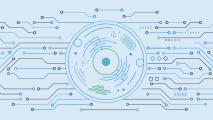Imagine a world in which genetic diseases are a thing of the past: Huntington’s disease, Tay-Sachs, and Cystic Fibrosis are nothing but a distant memory, reminiscent of the way we regard the rampant infectious diseases of the 18th century and before. Our great-grandchildren listen with fascination and horror to stories of how their ancestors suffered from beta-thalassemia, hemochromatosis, breast cancer, and Alzheimer’s disease. They wonder how we ever dealt with the uncertainty of when a familial disease might strike, or whom it might take down.
With the rise of genetic engineering technology, this future is on its way to being realized. And if we have the power to reduce genetic diseases at such a scale, we must ask ourselves whether we have a moral imperative to do so.
There are over six thousand diseases with a known genetic basis, that impact 75 million people each year. And for the first time ever, we have a shot at preventing or curing many of these.
Daisy Robinton, Ph.D.
I remember with great clarity the year that my older sister Lily was diagnosed with Type I diabetes. I was just seven years old, Lily was eleven, and our youthful days were filled with school, soccer, and friends. We slept in adjoining bedrooms separated by a glass door – a door that soon became a window into a kind of life I’d previously had no concept of.
Each night at three in the morning, I would wake to light filtering into my room from Lily’s. My dad would be at her bedside, quietly cajoling her to prick her finger and test her blood sugar, to ensure her glucose levels were in a safe range. Slowly, painstakingly, Lily adjusted to a new life replete with needles and careful control of her blood sugar.
I remember especially the few terrifying nights that Lily “crashed” – when her blood sugar fell dangerously low, and she passed out, prompting my dad to squeeze sugary goo into her mouth and stay by her side until she regained consciousness — crying, upset, and confused.
Needless to say, my education from the other side of that glass door was one of the most profound and moving experiences of my life. This experience seeded a passion in me to understand disease, to understand biology at a fundamental level, so that I might be able to help patients and families who face difficult challenges to their health.
Now, with the invention of genetic engineering and the discovery of CRISPR-Cas9, we have an opportunity not only to cure genetic diseases, but we may be able to prevent these diseases from ever coming into being. We may be able to eradicate many genetic diseases entirely. The era of genetically modified humans has arrived, and we must decide how this powerful new technology will shape the future of human health and human life.
Is There a Germline Red Line?
The development of CRISPR-mediated genetic engineering has ushered in an era of enormous discovery and transformed the landscape of biomedical research, as well as the treatment and prevention of genetic diseases. CRISPR gene editing enables precise modification of DNA to “correct” or replace faulty genes that give rise to genetic diseases in humans.
While these techniques are rapidly evolving to become safer, more precise, and easier to use, discussion has intensified relating to whether or how we should move forward with genetic engineering in humans, with a particularly passionate debate around the use of gene editing in germline cells.
An important distinction must be made between somatic gene editing and germline gene editing for reproductive purposes. Somatic gene editing applies to the cells of the body (soma), such as the liver, lungs, eyes or brain. Changes made to the somatic tissue are made in the body of an individual, and those changes remain with that individual.
In fact, somatic gene editing is already in use: clinical trials initiated earlier this year employed gene editing to successfully improve the vision of people suffering from hereditary blindness. Additional clinical trials are underway using gene editing to combat cancer and to treat patients with blood disorders.
Germline gene editing, on the other hand, modifies DNA in the sperm, eggs, or embryo. Any individual resulting from those cells will contain the DNA modifications in most – if not all – of their cells, and those changes will be passed on to any children that person has, making these changes heritable.
Utilizing germline gene editing means that we are changing the genetics of future generations of human beings — and the genetic legacy of humans as a species. It would radically transform our ability to prevent genetic diseases in future generations, and has the power to eradicate certain genetic diseases from the human population entirely.
The hypothetical debate about genetically modified humans collided with reality in 2018, when a biochemist named He Jiankui performed the first genome editing of human embryos that were then implanted into a woman and brought to term. Lulu and Nana, the twin girls whose DNA he modified in an attempt to minimize their susceptibility to HIV, just celebrated their first birthday in October 2019.
While most of the world and scientists globally decried this act as inappropriate and irresponsible, it is impossible to ignore that the technology is here. The time is now to create appropriate regulatory guidelines to develop and use this technology responsibly, to prevent incurring any harm, and to engage in discussion with multiple stake holders – not just scientists and politicians, but community members, philosophers, lawyers, policy makers, ethicists, and diverse people of all ages.
We must ask ourselves, what vision of the future do we want to create?
Disease Protection vs Genetic Enhancements
It feels easy for me to reflect on my family experience and conclude that I would modify the DNA of my own child, if it meant that she would not suffer as my sister had, being diagnosed at such a young age with a challenging, life-long disease. And that’s not to mention the more serious diseases, such as Duchenne muscular dystrophy and other neurodegenerative disorders.
Do we stop at serious and devastating diseases, or is it permissible to genetically engineer humans with additional protections — or enhancements? For example, many rare protective gene variants would have an outsized positive impact on our health and well-being: LRP5 facilitates extra strong bones, GHR and GH are associated with a low risk of cancer, and CCR5 and FUT2 offer viral resistance.
What if we were to install a series of genetic modifications that provide lifelong protection against cancer, neurodegenerative diseases like Alzheimer’s, muscle or bone frailty, and even aging itself? What if we could eradicate the majority of genetic diseases in future generations, much like we have largely removed many infectious diseases through immunization?
A 2017 joint report from the U.S. National Academy of Sciences and National Academy of Medicine recommended that genetic modification of human embryos only be permitted when there is a “serious disease or condition” to address with “no reasonable alternatives” available — and even then, we must wait for the technology to be ready and safe to give it a try. A poll in 2018 showed that 7 in 10 Americans are in favor of one day using gene editing technology to prevent fatal or incurable genetic diseases in a child, and two thirds favor using gene editing to prevent heritable non-fatal conditions or to reduce the risk of diseases that could develop later in life, such as cancer.
People seem to be comfortable using this technology to restore a lost function or prevent disease, to take initiative to level the playing field, so to speak. However, they are less comfortable with any modification that might offer an individual an advantage over a “regular” person, for fear of the inequality that it creates.
Do we stop at serious and devastating diseases, or is it permissible to genetically engineer humans with additional protections — or enhancements?
Daisy Robinton, Ph.D.
There are over six thousand diseases with a known genetic basis. And for the first time ever, we have a shot at preventing or curing many of these and improving the lives of not only the patients suffering, but the families and communities that support those patients. The potential impact is reminiscent of that of vaccines which eliminated smallpox and have largely eradicated a number of other infectious diseases, such as polio. A recent review estimates that, in the United States alone, vaccination has prevented some 103 million cases of selected infectious diseases.
Genetic engineering is poised to have a similarly profound impact on global health — the newest technological development, called “prime editing,” could correct 89% of genetic defects. Within the next few years, a number of gene editing therapies will surely be approved and available to treat adults or children already born, and we will likely see the first wave of genetic engineering in human embryos within the next decade.
Many detractors of genetic engineering technology argue that meddling with our genes is “unnatural.” But the obsession with doing only what is “natural” does not align with how we’ve already engineered our world to suit our needs. People choose to have cosmetic surgery to alter their appearance, Lasik eye surgery to improve their vision, or the installation of hearing aids to assist with hearing. We already engineer our bodies to support not only our health and well-being, but also aesthetic preferences. We have been doing unnatural things to our bodies for centuries.
With the possibilities of human genetic engineering in mind, I wonder: what do we need to know or think about now so that we can make thoughtful, responsible decisions? And what do we need to do — emotionally, mentally, physically, and spiritually — in order to be prepared for what this future will bring?
Questioning the Moral Imperative
While the possibilities are very exciting, many moral and ethical questions remain unanswered. Prospective parents at high risk for creating a child with a serious genetic disease do have viable options: current technologies that are safe and widely used allow for a couple to undergo in vitro fertilization followed by pre-implantation genetic diagnosis (PGD) to screen for genetic diseases. This would enable selection of an embryo that is unaffected by the disease in question. If a couple is intent having genetically related children free of genetic disease, this can be achieved in most cases using in vitro fertilization and PGD.
Many detractors of genetic engineering technology argue that meddling with our genes is “unnatural.” But the obsession with doing only what is “natural” does not align with how we’ve already engineered our world to suit our needs.
Daisy Robinton, Ph.D.
Of course, adoption is an important option to consider, as well. Bearing this in mind, it remains an open question whether there is a moral need to implement germline gene editing when other safe options exist. Using germline gene editing does not cure a disease that otherwise would exist; it aids in creating a person without a specific genetic disease who would otherwise not exist — a subtle distinction that calls into question the moral imperative of reproductive uses for this technology. The choice remains for prospective parents whether or not to have a child at high risk for genetic disease.
Our Genetic Legacy
While much of this requires further discussion, especially with regard to when, where, and how we might consider gene editing of humans for reproductive purposes, the era of genetically modified humans has arrived. This kind of progress raises the question: what will the future of humans look like when we have a more direct hand in designing the life that comes from us? How might you feel knowing that you were the product of direct design by your parents? What if their whims were employed to not only reduce your likelihood of developing a genetic disease, but to increase your likelihood of certain traits of their choice?
This potential future brings a new gravity to parental expectations and the pressure to grow and evolve in a particular way at the individual level. I can’t help but wonder how far I would be willing to go to have a genetically related child, a child that is free of genetic disease and poised to thrive. We have entered an era where we must choose how to proceed with these powerful technologies that are changing how we make babies and what it means to be human.
What will the future of humans look like when we have a more direct hand in designing the life that comes from us?
Daisy Robinton, Ph.D.
In this era of worry about the legacy we are leaving to our children, what kind of world we are allowing them to inherit, let us also think carefully about the genetic legacy we are offering. We have never before held so much responsibility in this dimension. It does not make sense to keep a death grip on that which seems “natural”: while altering the fundamental building blocks of who we are may feel scary, this ability offers an opportunity to reduce massive amounts of suffering for future generations to come.
We must come together as a community prepared to have an informed discussion around what kind of future we want to create, what kind of legacy we would like to leave to those who come after us. The era of genetically engineered humans is here, and we would do ourselves and the human race a great service by educating ourselves and reflecting on what we want this to look like in practice, and what it will mean not only for humanity but for all life on Earth.
Ed. Note: An early version of this article stated that “there are over 10,000 monogenic diseases.” This piece has been updated to reflect current studies stating that there are over 6K disease.






